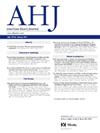Pharmaco-invasive strategy and dosing of tenecteplase in STEMI patients 60 to <75 years: An inter-trial comparison of the STREAM-1 and STREAM-2 trials
IF 3.7
2区 医学
Q1 CARDIAC & CARDIOVASCULAR SYSTEMS
引用次数: 0
Abstract
Background
Previous studies indicate a safety risk with full-dose TNK in elderly patients. In a study of patients ≥60 years STREAM-2 (STrategic Reperfusion Early After Myocardial infarction-2), a pharmaco-invasive (PI) strategy with half-dose TNK was similar (in efficacy and safety) to primary percutaneous coronary intervention (PPCI) in ST-elevation myocardial infarction (STEMI) patients presenting <3 hours. While no treatment difference ± 75 years was observed, the role of this half-dose PI strategy in patients <75 years is unknown. In this comparison of STEAM-1 and -2, we analyzed PI strategies with full-dose (STREAM-1) versus half-dose TNK (STREAM-2) to evaluate their relative efficacy and safety in this younger STEMI cohort.
Methods
We evaluated patients 60 to <75 years from STREAM-1 and STREAM-2 receiving PI treatment versus PPCI for their resolution of ST-elevation after fibrinolysis and angiography, primary efficacy composite of 30-day all-cause death, myocardial infarction, heart failure, and shock, and safety events.
Results
Among 1103 patients, 327 received a full-dose PI strategy (STREAM-1), 289 a half-dose PI strategy (STREAM-2) and 487 PPCI (338 in STREAM-1; 149 in STREAM-2). Half- compared to full-dose TNK resulted in similar proportions of patients achieving ST resolution ≥50% (71.2% vs 68.7%, P = .519): their ICH risks were 2.1% vs 1.5%, P = .605 respectively). Following angiography, PI patients had nominally better ST resolution ≥50% compared to their PPCI counterpart (STREAM-1: 87.7% vs. 83.2%, P = .120; STREAM-2: 88.2% vs. 81.0%, P = .048) with similar primary composite outcome at 30 days (STREAM-1: 14.4% vs. 16.3%, 0.90 [0.62, 1.31]; STREAM-2: 9.0% vs 8.1%, 1.29 [0.64, 2.61]). Major (non-ICH) bleeding markedly declined in STREAM-2 compared to STREAM-1 in both treatment groups (STREAM-1: 7.1% vs. 6.0%; STREAM-2: 0.3% vs. 0.7%).
Conclusions
In STEMI patients 60 to <75 years presenting within 3 hours of symptoms, half-dose PI treatment appears as efficacious as a full-dose PI strategy with a low systemic bleeding risk. Half-dose PI treatment deserves consideration when timely PPCI is not attainable in this important STEMI sub-group.
Clinicaltrials.gov registration numbers
NCT00623623, NCT02777580.
60至75岁STEMI患者的药物侵入策略和替奈普酶的剂量:STREAM-1和STREAM-2试验的试验间比较:STREAM-1和STREAM-2的60至75岁患者的比较
背景:先前的研究表明,全剂量TNK在老年患者中存在安全风险。在一项针对≥60岁的患者STREAM-2(心肌梗死后早期策略性再灌注-2)的研究中,半剂量TNK的药物侵入(PI)策略与st段抬高型心肌梗死(STEMI)患者的原发性经皮冠状动脉介入治疗(PPCI)相似(在有效性和安全性方面)。方法:我们评估了患者60至结果:在1103例患者中,327例接受了全剂量PI策略(STREAM-1), 289例接受了半剂量PI策略(STREAM-2), 487例PPCI (STREAM-1中338例;流-2中的149)。与全剂量TNK相比,半剂量TNK导致ST消退≥50%的患者比例相似(71.2% vs 68.7%, p=0.519):他们的ICH风险分别为2.1% vs 1.5%, p=0.605)。血管造影后,PI患者与PPCI患者相比,名义上ST分辨率更高,≥50% (STREAM-1: 87.7% vs. 83.2%, p=0.120;STREAM-2: 88.2% vs. 81.0%, p=0.048), 30天的主要综合结局相似(STREAM-1: 14.4% vs. 16.3%, 0.90 [0.62, 1.31];STREAM-2: 9.0% vs 8.1%, 1.29[0.64, 2.61])。与STREAM-1相比,两个治疗组STREAM-2的大出血(非脑出血)明显下降(STREAM-1: 7.1% vs. 6.0%;STREAM-2: 0.3% vs. 0.7%)。结论:在STEMI患者60至临床试验中:政府注册号:NCT00623623, NCT02777580。
本文章由计算机程序翻译,如有差异,请以英文原文为准。
求助全文
约1分钟内获得全文
求助全文
来源期刊

American heart journal
医学-心血管系统
CiteScore
8.20
自引率
2.10%
发文量
214
审稿时长
38 days
期刊介绍:
The American Heart Journal will consider for publication suitable articles on topics pertaining to the broad discipline of cardiovascular disease. Our goal is to provide the reader primary investigation, scholarly review, and opinion concerning the practice of cardiovascular medicine. We especially encourage submission of 3 types of reports that are not frequently seen in cardiovascular journals: negative clinical studies, reports on study designs, and studies involving the organization of medical care. The Journal does not accept individual case reports or original articles involving bench laboratory or animal research.
 求助内容:
求助内容: 应助结果提醒方式:
应助结果提醒方式:


